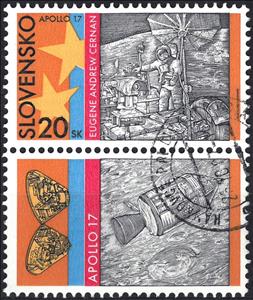Stamp: 30th Anniversary of Apollo 17 Moonflight - E. A. Cernan (Slovakia 2002)
30th Anniversary of Apollo 17 Moonflight - E. A. Cernan (Slovakia 2002)
06 December (Slovakia ) within release Anniversary goes into circulation Stamp 30th Anniversary of Apollo 17 Moonflight - E. A. Cernan face value 20 Slovak koruna
| Stamp 30th Anniversary of Apollo 17 Moonflight - E. A. Cernan in catalogues | |
|---|---|
| Michel: | Mi: SK 440Zf |
Stamp is square format.
Also in the issue Anniversary:
- Souvenir Sheet - 30th Anniv. of Apollo 17 Space Travel face value 20;
- Stamp - 30th Anniversary of Apollo 17 Moonflight - E. A. Cernan face value 20;
Stamp 30th Anniversary of Apollo 17 Moonflight - E. A. Cernan it reflects the thematic directions:
An anniversary is the date on which an event took place or an institution was founded in a previous year, and may also refer to the commemoration or celebration of that event. For example, the first event is the initial occurrence or, if planned, the inaugural of the event. One year later would be the first anniversary of that event. The word was first used for Catholic feasts to commemorate saints. Most countries celebrate national anniversaries, typically called national days. These could be the date of independence of the nation or the adoption of a new constitution or form of government. The important dates in a sitting monarch's reign may also be commemorated, an event often referred to as a "Jubilee".
An astronaut (from the Ancient Greek ἄστρον (astron), meaning 'star', and ναύτης (nautes), meaning 'sailor') is a person trained, equipped, and deployed by a human spaceflight program to serve as a commander or crew member aboard a spacecraft. Although generally reserved for professional space travelers, the term is sometimes applied to anyone who travels into space, including scientists, politicians, journalists, and tourists
The Moon is Earth's only natural satellite. It orbits at an average distance of 384,400 km (238,900 mi), about 30 times the diameter of Earth. Tidal forces between Earth and the Moon have over time synchronized the Moon's orbital period (lunar month) with its rotation period (lunar day) at 29.5 Earth days, causing the same side of the Moon to always face Earth. The Moon's gravitational pull – and to a lesser extent, the Sun's – are the main drivers of Earth's tides.
Outer space (or simply space) is the expanse that exists beyond Earth's atmosphere and between celestial bodies. It contains ultra-low levels of particle densities, constituting a near-perfect vacuum of predominantly hydrogen and helium plasma, permeated by electromagnetic radiation, cosmic rays, neutrinos, magnetic fields and dust. The baseline temperature of outer space, as set by the background radiation from the Big Bang, is 2.7 kelvins (−270 °C; −455 °F)




